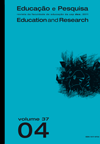Reflections on homophobia and education in schools in the interior of Sao Paulo state
DOI:
https://doi.org/10.1590/S1517-97022011000400004Keywords:
Homophobia and education, Homophobic violence, Adolescence, Sexuality, HomosexualityAbstract
This is a survey conducted in 2009 with 2,282 students of both sexes enrolled in the three grades of high school in three cities of the west of Sao Paulo state (Assis, Presidente Prudente and Ourinhos). The data collection instrument was a self-administered and anonymous questionnaire with 131 questions. In this article, we reflect on how in schools the research participants reproduce and reinforce the hegemonic discourses of control of sexualities guided by the attempt to promote heterosexuality as the only form of sexual intelligibility, to the detriment of other forms of expression of sexuality. We discuss how homophobia and the devices of social control of sexuality (re) produce prejudices and stereotypies, resulting in vulnerabilities that non-heterosexual teenagers have, such as homophobic victimization, social and affective isolation, ideations and suicide attempts. The study shows that the invariant were discrimination, homophobic violence and the insults that are perpetrated in the values and discourses of adolescents at school and in their family, demonstrating the institutionalization of homophobia as a regulatory practice of the psychological and social construction of gender and sexual identities. We highlight how important it is for the school to appropriate the means of deconstruction of heterocentric normativity to preserve the rights and citizenship of the people who do not identify with the prevailing models of heterosexuality.Downloads
Download data is not yet available.
Downloads
Published
2011-12-01
Issue
Section
Articles
License
Authors assume exclusive responsibility for the concepts expressed in their articles, which do not necessarily reflect the journal’s opinion.
Permission to photocopy all or part of the material published in the journal is granted provided that the original source of publication be assigned.
How to Cite
Reflections on homophobia and education in schools in the interior of Sao Paulo state . (2011). Educação E Pesquisa, 37(4), 725-741. https://doi.org/10.1590/S1517-97022011000400004



